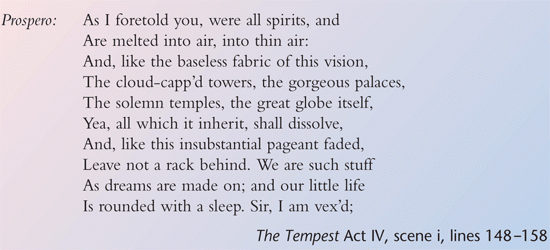Use of Imagery
Imagery involves the use of emotionally charged words and phrases, which create vivid pictures in the minds of the readers or listeners. Shakespeare’s imagery often includes metaphors or similes.
A simile compares one thing to another using ‘like’ or ‘as’. For example, Juliet’s words to Romeo: ‘My bounty is as boundless as the sea, My love as deep.’
A metaphor is also a form of comparison but, instead of using ‘like’ or ‘as’, it suggests that the thing being described, and the thing compared to it, are the same. Donalbain’s warning to brother Malcolm in Macbeth: ‘There’s daggers in men’s smiles’
This video explains Shakespeare use of imagery, including his use of metaphors and similes.
Shakespeare often uses imagery to explore and add emphasis to a particular idea. In The Tempest, for example, Prospero compares the brief and temporary nature of the span of a human life with the impermanent nature of actors acting out a part in the theatre.

In a play, there are often groups of images that are repeated and which build up a sense of the themes the play explores.
For example, in Othello the evil Iago is frequently linked with the idea of hell through the imagery of the play. Here are just a few examples:
- He swears by the ‘divinity of hell ’ (Act II, scene iii, line 341).
- He suggests to Roderigo that his wits are working with ‘All the tribe of hell ’ (Act I, scene iii, line 358).
- He explains how his untoward trustworthiness conceals his evil: ‘When devils will the blackest sins put on, They do suggest at first with heavenly shows As I do now.’ (Act II, scene iii, lines 342–344)
On the other hand, the ‘divine’ Desdemona is, from her first appearance in the play to the last, a figure of heavenly purity and goodness and this too is stressed through the repeated use of images that link her to the idea of heaven, as when Cassio welcomes her and prays that: ‘…the grace of heaven Before, behind thee, and on every hand, Enwheel thee round.’ (Act II, scene i, lines 85–87)
The heaven and hell imagery is used to highlight and explore one of the key themes of the play – that of the contrast between good and evil.
